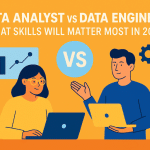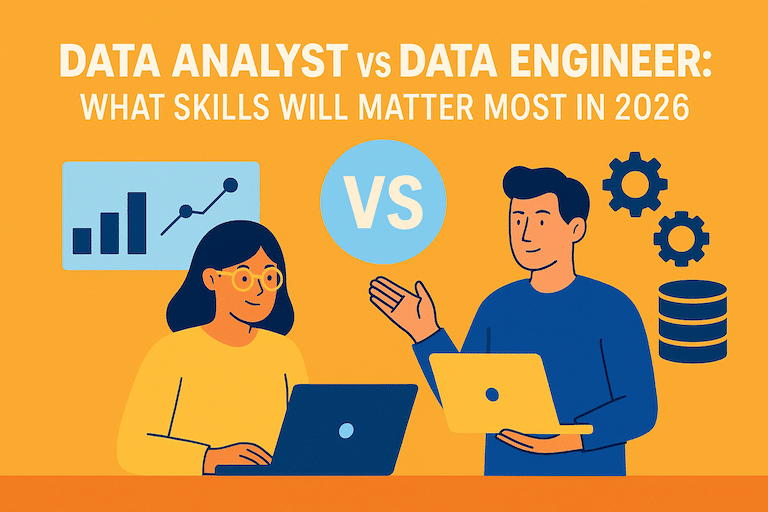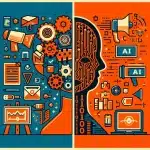
Data Analyst vs Data Engineer: What Skills Will Matter Most in 2026
We all know that data is the new currency, which means that expectations continue to rise, and rightfully so, in terms of what data analysis and business intelligence teams can deliver. As organisations seek to grow within a complex digital world, the roles of Data Analyst and Data Engineer have become cornerstones of success. Yet, the ground beneath these professions is shifting rapidly. The skills that defined excellence yesterday are merely the baseline for tomorrow. Statistical tools used to be about reporting; now they’re about predictive analysis, and the C-Suite is much more open to hearing suggestions and ideas from a data architect or a business analyst. As we look toward 2026, a new set of competencies is emerging, driven by advancements in AI, the dominance of the cloud, and an unrelenting demand for real-time insights.
The Critical Distinction in a Data-Driven World
At their core, Data Analysts and Data Engineers serve two distinct but deeply interconnected functions. The Data Engineer builds the highways, designing, constructing, and maintaining the robust data infrastructure that collects, stores, and transports information. They are the architects of the data ecosystem. The Data Analyst, in contrast, drives on these highways. They take the prepared data, analyse it, and translate it into compelling narratives and actionable insights that guide business decisions. One builds the foundation; the other builds the skyscraper of understanding upon it.
Why 2026 Demands a Fresh Perspective on Data Skills
The sheer volume of information being created is staggering; in 2023, an estimated 132 zettabytes of data were generated worldwide. This data explosion, coupled with the rapid maturation of AI and cloud computing, is fundamentally reshaping job requirements. The global data analytics market, valued at $64.99 billion in 2024, is projected to surge to $402.7 billion by 2032, signalling an unprecedented demand for skilled professionals. For both analysts and engineers, this is the opportunity to stand out and elevate the function to a new, strategic level.
Understanding the Core Roles: Foundation for 2026
Before dissecting the future-forward skills, it’s crucial to solidify our understanding of these foundational roles as they exist today.
The Data Analyst: Transforming Data into Actionable Insights
A Data Analyst is a translator and a storyteller. Their primary mandate is to query, clean, and analyse datasets to answer critical business questions. They identify trends, patterns, and correlations that would otherwise remain hidden within raw numbers. Using business intelligence (BI) tools and statistical methods, they create dashboards, reports, and visualizations that empower stakeholders to make informed decisions. The demand for these skills is robust, with the U.S. Bureau of Labor Statistics projecting a 23% increase in the job market for data analysts by 2032. Their work directly influences marketing campaigns, operational efficiencies, and strategic planning.
The Data Engineer: Building and Maintaining the Data Infrastructure
A Data Engineer is the bedrock of any data-driven organisation. They are responsible for the entire data lifecycle before it reaches the analyst. This includes understanding big data technologies, designing scalable data pipelines, implementing ETL (Extract, Transform, Load) or ELT (Extract, Load, Transform) processes, and managing data warehouses and data lakes. They ensure data collection is reliable, accessible, and secure. Without proficient data engineering, and data integration, analysts and data scientists would be starved of the high-quality information they need to perform their work. Their focus is on system architecture, programming, and database optimisation, ensuring the data ecosystem is efficient and scalable.
The 2025 Data Landscape: Key Trends Shaping Skill Demands
The forces transforming the data world are converging, creating a new set of expectations for both analysts and engineers by 2026.
Hyper-Scalability, Real-time Processing, and Cloud-Native Solutions
The era of on-premise servers is giving way to the cloud. Platforms like AWS, Azure, and Google Cloud Platform (GCP) offer unparalleled scalability and flexibility. For 2026, proficiency in cloud-native tools is no longer a “nice-to-have” but a core requirement. Furthermore, businesses are moving from batch processing to real-time analytics, demanding infrastructure that can ingest and process streaming data instantaneously to power live dashboards and immediate decision-making.
The Proliferation of AI, Machine Learning, and Automated Intelligence
Artificial intelligence is no longer a futuristic concept; it’s a present-day tool that is augmenting data roles. The impact is profound, with job postings mentioning generative AI skills increasing 267% year-over-year in early 2024. For analysts, AI-powered tools can automate data cleaning and preliminary analysis, shifting their focus to higher-level interpretation and strategic thinking. For engineers, the rise of MLOps (Machine Learning Operations) means they are now responsible for building the data pipelines and infrastructure that train and deploy machine learning models.
Data Governance, Ethics, and Security as Non-Negotiable
With increasing data regulations like GDPR and CCPA, and a greater public awareness of data privacy, robust data governance is paramount. In 2026, both roles must be deeply versed in the principles of data ethics, security, and compliance. Engineers must build systems with security-by-design, while analysts must understand the ethical implications of their analyses and ensure their insights are derived and used responsibly.
Data Analyst: Essential Skills for 2026
To thrive in the coming years, Data Analysts must evolve from report builders to strategic partners.
Advanced Analytical and Statistical Prowess
A solid foundation in statistics remains critical, but the 2026 analyst needs more. This includes a working knowledge of predictive modelling, A/B testing at scale, and the ability to interpret the outputs of machine learning models. They must move beyond describing what happened to predicting what will happen next.
AI-Augmented Insights and Generative AI Proficiency
Analysts in 2026 will use generative AI as a co-pilot. This means mastering prompt engineering to accelerate data exploration and report generation. Crucially, it also means developing the critical thinking skills to validate AI-generated outputs, identify potential biases, and synthesize AI findings into a coherent business strategy.
Compelling Data Storytelling and Communication Skills
The ability to create a dashboard is baseline. The elite analyst of 2026 will be a master storyteller, capable of weaving data points into a compelling narrative that resonates with non-technical stakeholders. This involves advanced data visualization tools combined with exceptional presentation and communication abilities to drive action and influence strategy.
Data Quality Interpretation and Governance Adherence
Analysts can no longer be passive consumers of data. They must become active participants in data quality. This involves understanding data lineage, being able to identify and flag inconsistencies, and working with engineers to improve data sources. They must also operate strictly within the bounds of data governance policies.
Data Engineer: Essential Skills for 2026
The demand for Data Engineers is surging as companies recognize that infrastructure is a prerequisite for insight. The global big data and data engineering services market is projected to exceed $106 billion in 2025.
Cloud-Native Data Engineering & Architecture
Deep expertise in at least one major cloud provider (AWS, GCP, Azure) is non-negotiable. This includes proficiency with cloud data warehouses (Snowflake, BigQuery, Redshift), data lake solutions (S3, ADLS), and serverless computing. The growth of the Data Engineering as a Service (DaaS) market to $13.2 billion by 2026 underscores this cloud-centric shift.
Real-time Data Streaming and Processing
Proficiency in data streaming technologies like Apache Kafka, Apache Flink, and cloud-based services like AWS Kinesis is becoming a core requirement. Engineers must be able to design and build pipelines that can handle high-velocity, real-time data feeds for instant analytics.
Advanced Data Pipeline Automation and Orchestration
Modern data ecosystems require sophisticated automation. Mastery of workflow orchestration tools like Airflow, Dagster, or Prefect is essential for building, scheduling, and monitoring complex data pipelines. An understanding of DataOps principles (applying DevOps methodologies to data analytics) is key to ensuring reliability and efficiency.
Database Management, Data Modelling, and System Design
While new technologies emerge, foundational skills remain vital. Expert-level SQL, deep knowledge of both relational (e.g., PostgreSQL) and NoSQL databases, and the ability to design efficient and scalable data models are the bedrock upon which all other engineering skills are built.
MLOps Infrastructure and AI/ML Data Readiness
As companies operationalize machine learning, engineers are increasingly tasked with building the infrastructure to support it. This includes creating data pipelines for model training and inference, managing feature stores, and ensuring data is clean and properly formatted for ML consumption. This skill bridges the gap between data engineering and data science.
The Symbiotic Relationship: How Analysts and Engineers Collaborate for 2026 Success
Siloes are the enemy of a data-driven culture. The future belongs to organizations where analysts and engineers work in a tight, collaborative loop.
Bridging the Gap: Data Literacy for Both Roles
For effective collaboration, cross-functional understanding is key. Engineers in 2026 must grasp the business context behind the data they are provisioning. Analysts must have a foundational understanding of data architecture to make feasible requests and understand data limitations. This shared literacy prevents misunderstandings and accelerates project delivery.
Agile Feedback Loops and Iterative Development
The most successful data teams operate within an agile framework. Analysts provide engineers with immediate feedback on data quality and usability, while engineers inform analysts of new data sources or structural changes. This iterative process ensures that the data infrastructure evolves in lockstep with business needs.
Shared Goal: Empowering Data-Driven Business Decisions
Ultimately, both roles serve the same master: the business. When analysts and engineers share a common understanding of organisational goals, their collaboration becomes a powerful engine for growth. The engineer provides the reliable fuel (data), and the analyst navigates the vehicle (insights) toward the strategic destination.
Structure your team: What to recruit for
As a data leader building a team for 2026, your hiring strategy must evolve beyond traditional skill checks. For Data Analysts, look past candidates who only list SQL and Tableau. Prioritise those who demonstrate exceptional business acumen and curiosity. Ask them to walk you through a project where they influenced a business decision, not just produced a report. The key differentiator is their ability to translate data into a strategic narrative. Screen for candidates who are conversant in the potential of generative AI and can articulate how they would use it as a tool for deeper, faster inquiry.
When recruiting Data Engineers, move beyond legacy ETL processes. Your top candidates must be cloud-fluent, with demonstrable projects on AWS, GCP, or Azure. Probe for experience with infrastructure-as-code (e.g., Terraform) and containerization (Docker, Kubernetes). The modern engineer thinks in terms of automation and scalability. Look for a “DataOps” mindset: someone who values testing, monitoring, and iterative improvement. A critical, often overlooked, trait is their ability to collaborate with analysts; ask how they have worked with stakeholders to understand data requirements and ensure usability. The best engineers are not just coders; they are architects who understand their end-users.
In Concluding: The Future is Data-Driven and Collaborative
The distinction between Data Analysts and Data Engineers remains clear, yet their interdependence has never been stronger.
The Data Engineer of 2026 is a cloud-native architect and an automation expert, building the sophisticated data systems that power real-time intelligence and AI. The Data Analyst is a strategic storyteller and an AI-augmented thinker, transforming this data into predictive insights and compelling business narratives. For professionals in these fields, the path forward is clear: embrace continuous learning, cultivate cross-functional understanding, and master the new skills demanded by an increasingly complex and exciting data landscape. For organisations, building teams that foster this collaboration is the ultimate competitive advantage. Analytics careers will only expand, an AI specialist will find many opportunities in this domain, but only if they apply enough model innovation to give your team the push it needs to go become recognised as the home of today’s data architects.
Need support with your data analytics?
Amos Hauck
Your blog is a breath of fresh air in the often stagnant world of online content. Your thoughtful analysis and insightful commentary never fail to leave a lasting impression. Thank you for sharing your wisdom with us.





















1 comment